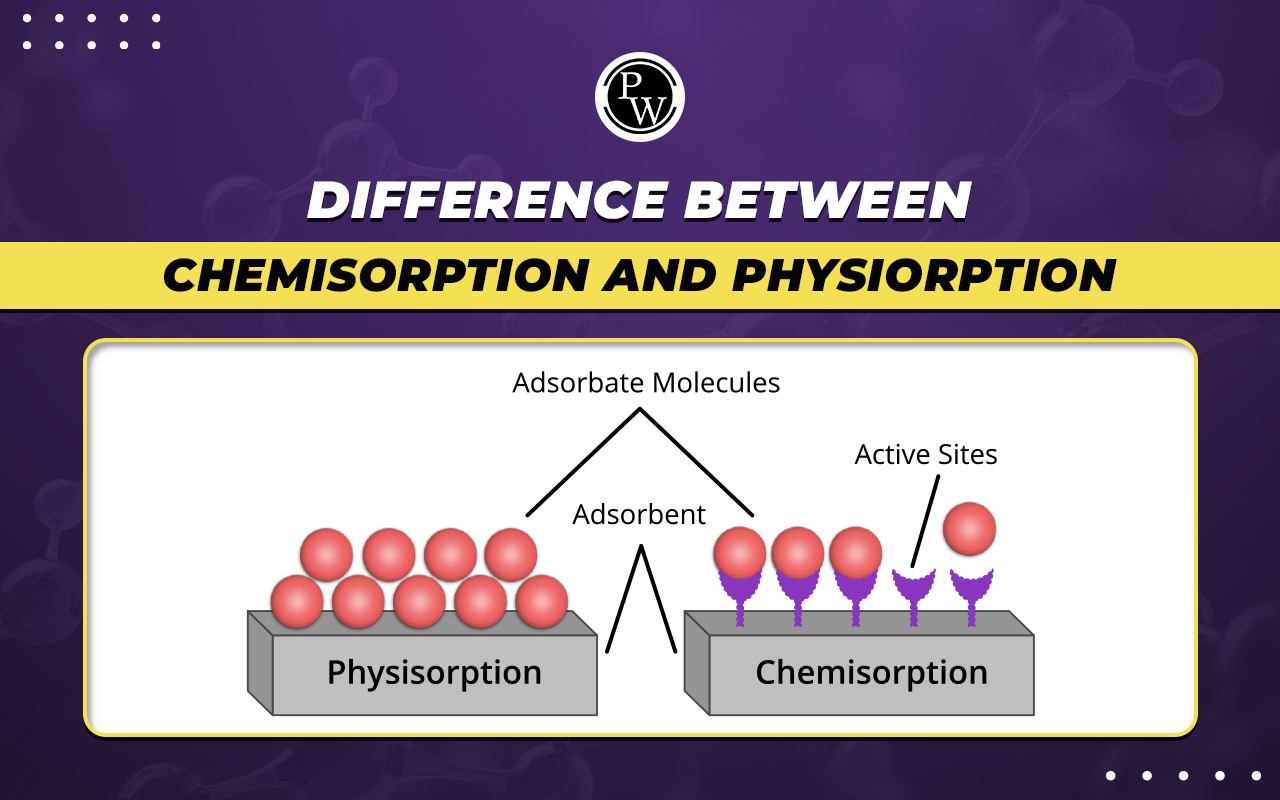

Difference Between Chemisorption And Physisorption : Chemistry is a broad subject that covers a lot of topics, including bases, acids, atoms, molecules, and chemical reactions. Learning and understanding the fundamentals of chemistry involves all of these topics. Chemicals are used in many different ways in our daily lives. We will go over the definition, types, and difference between chemisorption and physisorption in this discussion on adsorption. Adsorption is the thin-film process by which molecules of gas and liquid are held by a solid. Adsorption is essentially the process of atoms, molecules, or ions from a liquid or gaseous surface attaching to or fixing themselves. It's a method of mass transfer in chemistry. Adsorption of unsaturated forces occurs on solid surfaces. Achieve JEE excellence with PW JEE Online Course . Join now to fulfill your engineering dreams.
Types of Adsorption
Two types of adsorption are generally found, depending on the material being adsorbed and deposited, these types are:- Physisorption
- Chemisorption
What Is Physisorption
What Is Physisorption : The process that causes an atom's or molecule's structure to become unstable is known as physisorption. Physical adsorption, or the physical bonding of gas molecules to a liquid or solid surface, is another name for physisorption. At low temperatures, there is contact between the surfaces and the gas molecules. Interestingly, physisorption is generated by the intermolecular force between adsorbents and adsorbates. The solid surface is where most physisorption takes place. The force that this kind of adsorption shows is known as the "Van Der Waals Force,". The process of physisorption is exothermic. Because of the physisorption process's weakening of the van der Waals force, the volume, product pressure, and internal energy add up to a relatively low value. It is possible to reverse physisorption if the pressure is comparatively lowered. Numerous multi-molecular layers are produced via physisorption and this process doesn't need activation energy. Although it is little, the interaction energy in physisorption is considerable. Molecules and solid surface interactions are studied using the physisorption process. A typical example of physisorption is the adsorption of gases, such as hydrogen, nitrogen, and so forth. These gases have low temperature interactions. The surface area rises in parallel with the increase in adsorption. Therefore, the kind of adsorbate affects adsorption.What Is Chemisorption
What Is Chemisorption : Chemisorption is defined as the chemical reaction that occurs between an adsorbate and an adsorbent. The process involves transferring and sharing electrons between adsorbents and adsorbates. Chemisorption is an exothermic process that happens when the temperature rises. This process starts at a low temperature and gradually increases in pressure. This process results in the formation of a chemical bond, with a relatively large total of internal energy, volume, and product pressure. Examples of chemisorption include macroscopic processes such as rusting. Chemisorption is also seen in heterogeneous catalysts, where molecules interact with one another via chemisorbed intermediates. Chemisorption is a specific process. In this process, chemical linkages are formed between the adsorbents and adsorbates. These bonds may be either ionic or covalent in nature. The process requires a high activation energy as well as high temperatures. It is important to note that the chemisorption process is reversible. However, minor pressure variations have little effect on it. Thus, chemisorption occurs in the presence of high temperatures. Buy the JEE Exam Preparation Books For Latest UpdateKey Difference Between Chemisorption and Physisorption
Key Difference Between Chemisorption and Physisorption : There are many difference between chemisorption and physisorption, a few of which are mentioned below in the table:| Key Difference Between Chemisorption and Physisorption | |||
| S No | Property | Physisorption | Chemisorption |
| 1 | Definition | In physisorption, atoms or molecules experience unsettled structure. | Chemisorption involves the formation of chemical bonds between adsorbates and adsorbents. |
| 2 | Forces Involved | Van Der Waals forces are responsible for physisorption. | Chemisorption occurs due to the creation of chemical bonds. |
| 3 | Reversibility | Physisorption is reversible. | Chemisorption is irreversible. |
| 4 | Specificity | Physisorption is considered non-specific. | Chemisorption is relatively specific. |
| 5 | Temperature Conditions | Physisorption occurs at low temperatures. | Chemisorption takes place at high temperatures. |
| 6 | Temperature Effect | The physisorption process decreases with an increase in temperature. | Chemisorption process increases with an increase in temperature. |
| 7 | Layer Formation | Multi-molecular layers are formed in physisorption. | Uni-molecular layers are formed in chemisorption. |
| 8 | Activation Energy | Activation energy for physisorption is low. | Activation energy for chemisorption is quite high. |
Uses of Chemisorption
- Chemisorption is the preferred choice when dealing with liquid and solid molecules, especially when there's a requirement for establishing a lasting or semi-permanent bond between the adsorbent and the adsorbate.
- This process involves the physical and chemical interaction of a gas with a solid surface, finding applications in environmental cleanup, food production, and pharmaceuticals.
- Various agents like acids, bases, and catalysts can catalyze the gas adsorption onto the solid surface, leading to desorption and providing advantages such as enhanced production, improved quality, and cost reduction.
Uses of Physisorption
- Physisorption is primarily applied to gases and solids with low surface areas.
- To generate a very high level vacuum, a vacuum pump expelled the leftover charcoal adsorbed in a tank.
- To remove moisture and manage humidity, silica and aluminum gels are used as adsorbents in physisorption.
Difference Between Chemisorption and Physisorption FAQs
Q.1: Is chemisorption stronger than physisorption?
Ans. Molecules stick to surfaces by a mechanism called physisorption, which has an interaction up to 100 times weaker than chemisorption.
Q2: Is chemisorption endothermic or exothermic?
Ans. When compared to physical adsorption, chemisorption often has substantially higher adsorption temperatures, and in all those situations, chemisorption is really exothermic.
Q.3. What is chemisorption also known as?
Ans. There is creation of a chemical bond between the reactants and the adsorbent, so chemisorption is also known as active adsorption.
Q.4: What is the meaning of physisorption?
Ans. Physisorption is a physical adsorption process where an atom or molecule in the gas phase binds to a solid surface.
Q.5. What is an example of physisorption?
Ans. A chemical that desorbs tends to rise with the solvent front rather than sink to the stationary phase.
🔥 Trending Blogs
Talk to a counsellorHave doubts? Our support team will be happy to assist you!

Free Learning Resources
PW Books
Notes (Class 10-12)
PW Study Materials
Notes (Class 6-9)
Ncert Solutions
Govt Exams
Class 6th to 12th Online Courses
Govt Job Exams Courses
UPSC Coaching
Defence Exam Coaching
Gate Exam Coaching
Other Exams
Know about Physics Wallah
Physics Wallah is an Indian edtech platform that provides accessible & comprehensive learning experiences to students from Class 6th to postgraduate level. We also provide extensive NCERT solutions, sample paper, NEET, JEE Mains, BITSAT previous year papers & more such resources to students. Physics Wallah also caters to over 3.5 million registered students and over 78 lakh+ Youtube subscribers with 4.8 rating on its app.
We Stand Out because
We provide students with intensive courses with India’s qualified & experienced faculties & mentors. PW strives to make the learning experience comprehensive and accessible for students of all sections of society. We believe in empowering every single student who couldn't dream of a good career in engineering and medical field earlier.
Our Key Focus Areas
Physics Wallah's main focus is to make the learning experience as economical as possible for all students. With our affordable courses like Lakshya, Udaan and Arjuna and many others, we have been able to provide a platform for lakhs of aspirants. From providing Chemistry, Maths, Physics formula to giving e-books of eminent authors like RD Sharma, RS Aggarwal and Lakhmir Singh, PW focuses on every single student's need for preparation.
What Makes Us Different
Physics Wallah strives to develop a comprehensive pedagogical structure for students, where they get a state-of-the-art learning experience with study material and resources. Apart from catering students preparing for JEE Mains and NEET, PW also provides study material for each state board like Uttar Pradesh, Bihar, and others
Copyright © 2025 Physicswallah Limited All rights reserved.
Get App











